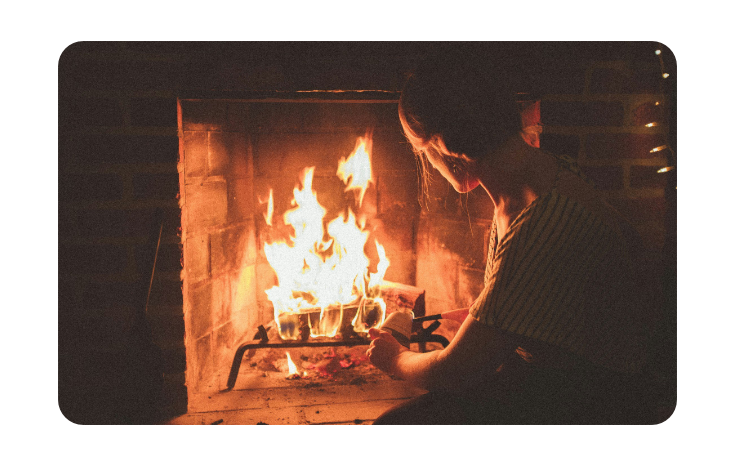Nothing is quite as warm and cozy as a crackling fire in fall. But before you touch match to kindling, take a good look around your fireplace and chimney to make sure you’re following these essential guidelines for a safe—and warm—season. Poorly maintained fireplaces can cause house fires or other dangers, so it’s important to take precautions now, before the season really kicks in. Whether your fireplace is gas or wood-burning with a gas starter we’ve got the tips you need to get your hearth ready for the cold months ahead.
Arrange a yearly inspection: All chimneys should be inspected and cleaned by a chimney cleaning professional at least once a year, or about once every 80 fires. A thorough cleaning will remove any buildup of creosote, an oily and highly flammable byproduct of burning wood, giving you a safer fireplace.
Check for cracks and damage: Check for cracks and loose joints of the firebricks inside the fireplace, and check the exterior masonry for damage. Hire a professional mason to do any repairs—never try to repair firebrick with regular mortar, as the mixture cannot stand up to high heat.
Inspect the chimney cap and damper: Make sure the fireplace damper is working properly and that there is no debris preventing it from opening and closing. Confirm that the chimney cap is firmly attached and in good condition. The cap should include protective screening to keep birds, squirrels, bats, and other pests from entering the chimney.
Clear away tree limbs: While you are outside checking the chimney cap, prune any overhanging tree limbs that may be encroaching on the chimney. Not only do tree limbs present a fire hazard, they can also restrict the proper draft of the chimney and damage the cap.
Clean out ashes: Clean out the firebox once a week, or whenever ash is more than an inch deep. Coals can remain hot for up to three days, so make sure everything is completely cold. Sweep or vacuum the cold ashes and dispose of them outside—wood ashes are perfect for garden beds and compost piles.
Consider heatproof glass: Consider installing heatproof glass doors to improve the energy efficiency of your fireplace. Doors can also prevent sparks from escaping the fireplace and damaging the surrounding flooring. If your fireplace already has glass doors, clean them with a paper towel and glass fireplace door cleaner.
Clean brass fireplaces: Clean a brass fireplace surround naturally by spreading a thin film of tomato paste, tomato sauce, or ketchup on it; letting it sit for an hour; and then cleaning with hot soapy water. Alternatively, you can use a good-quality commercial brass polish and a soft microfiber cloth. Avoid using highly abrasive scrubbing cloths, metal-bristled brushes, or steel wool.
Store wood outside the home: Stock up on good-quality firewood, and store it away from the house to avoid attracting pests. Hardwoods like oak, maple, and birch burn hotter and longer than soft woods like pine. You can also burn specially made fireplace logs, like Duraflame or Pres-to-Logs. Never burn treated or painted wood, which both produce dangerous fumes.
Maintain your gas fireplace: If you have a gas fireplace, check to make sure that the pilot light is on and the vents are all clear and working properly. Check the logs, liners, and burners for cracks, and replace any damaged components.
If you have a gas starter follow these simple tips:
Check the condition of your gas starter at the beginning of every season by examining the fittings for damage and testing the gas flow. Don’t allow ashes to pile up around the gas starter; remove ashes from the fireplace and place them in a sealed metal container after every fire or every other fire. If the ashes build up, they can interfere with proper air circulation in the fireplace and cause smoke to be drawn into the room.
Don’t use a fireplace with a gas line installed until you determine whether it is a gas fireplace or a wood-burning fireplace with a gas starter. Most gas fireplaces have fake logs behind a glass cover that you cannot open or close, but consult an expert if you are unsure. You should use your gas starter for only 10 or 15 minutes at a time; using a gas starter for extended periods can cause it to melt and fail.
Do your due diligence on fireplace maintenance; then cozy up by the fire all fall and winter long. If you find that you need assistance in relocating a gas starter or simply adding one, do give us a call at 678-598-6528. We can even switch your propane grill to gas or add a gas line and starter at your firepit.

Leave a Reply